外语教学法90分笔记
- 格式:doc
- 大小:352.50 KB
- 文档页数:76
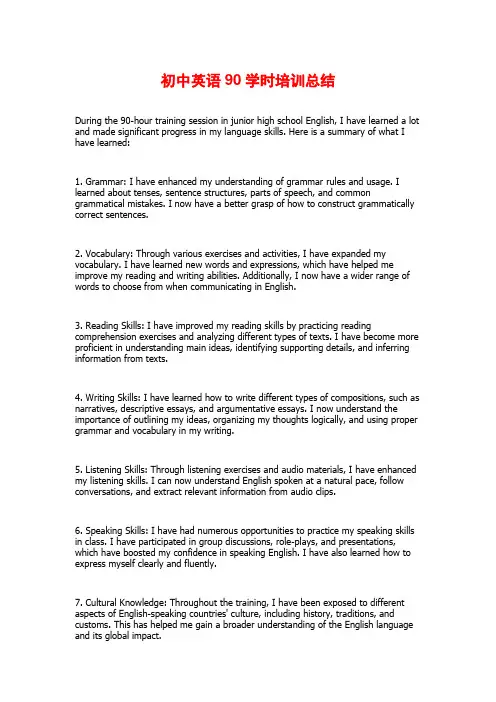
初中英语90学时培训总结During the 90-hour training session in junior high school English, I have learned a lot and made significant progress in my language skills. Here is a summary of what I have learned:1. Grammar: I have enhanced my understanding of grammar rules and usage. I learned about tenses, sentence structures, parts of speech, and common grammatical mistakes. I now have a better grasp of how to construct grammatically correct sentences.2. Vocabulary: Through various exercises and activities, I have expanded my vocabulary. I have learned new words and expressions, which have helped me improve my reading and writing abilities. Additionally, I now have a wider range of words to choose from when communicating in English.3. Reading Skills: I have improved my reading skills by practicing reading comprehension exercises and analyzing different types of texts. I have become more proficient in understanding main ideas, identifying supporting details, and inferring information from texts.4. Writing Skills: I have learned how to write different types of compositions, such as narratives, descriptive essays, and argumentative essays. I now understand the importance of outlining my ideas, organizing my thoughts logically, and using proper grammar and vocabulary in my writing.5. Listening Skills: Through listening exercises and audio materials, I have enhanced my listening skills. I can now understand English spoken at a natural pace, follow conversations, and extract relevant information from audio clips.6. Speaking Skills: I have had numerous opportunities to practice my speaking skills in class. I have participated in group discussions, role-plays, and presentations, which have boosted my confidence in speaking English. I have also learned how to express myself clearly and fluently.7. Cultural Knowledge: Throughout the training, I have been exposed to different aspects of English-speaking countries' culture, including history, traditions, and customs. This has helped me gain a broader understanding of the English language and its global impact.Overall, the 90-hour training session has been extremely beneficial and has significantly improved my English language skills. I feel more confident in my ability to communicate effectively in English and am excited to continue developing my language skills in the future.。
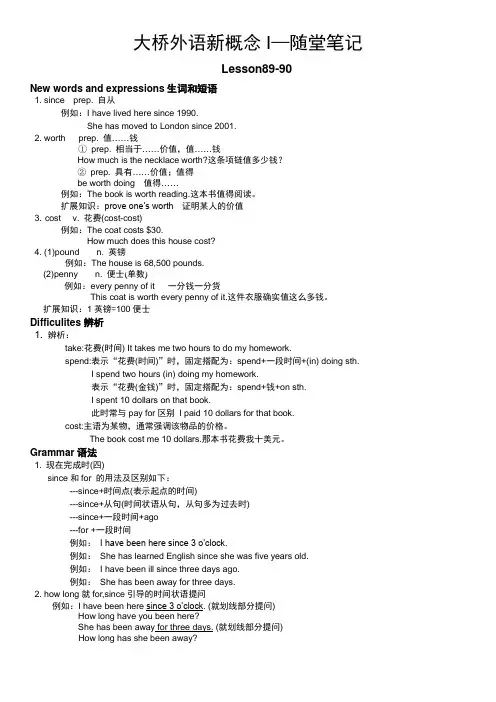
大桥外语新概念I—随堂笔记Lesson89-90New words and expressions生词和短语1. since prep. 自从例如:I have lived here since 1990.She has moved to London since 2001.2. worth prep. 值……钱①prep. 相当于……价值,值……钱How much is the necklace worth?这条项链值多少钱?②prep. 具有……价值;值得be worth doing 值得……例如:The book is worth reading.这本书值得阅读。
扩展知识:prove one’s worth 证明某人的价值3. cost v. 花费(cost-cost)例如:The coat costs $30.How much does this house cost?4. (1)pound n. 英镑例如:The house is 68,500 pounds.(2)penny n. 便士(单数)例如:every penny of it 一分钱一分货This coat is worth every penny of it.这件衣服确实值这么多钱。
扩展知识:1英镑=100便士Difficulites辨析1. 辨析:take:花费(时间) It takes me two hours to do my homework.spend:表示“花费(时间)”时,固定搭配为:spend+一段时间+(in) doing sth.I spend two hours (in) doing my homework.表示“花费(金钱)”时,固定搭配为:spend+钱+on sth.I spent 10 dollars on that book.此时常与pay for区别I paid 10 dollars for that book.cost:主语为某物,通常强调该物品的价格。
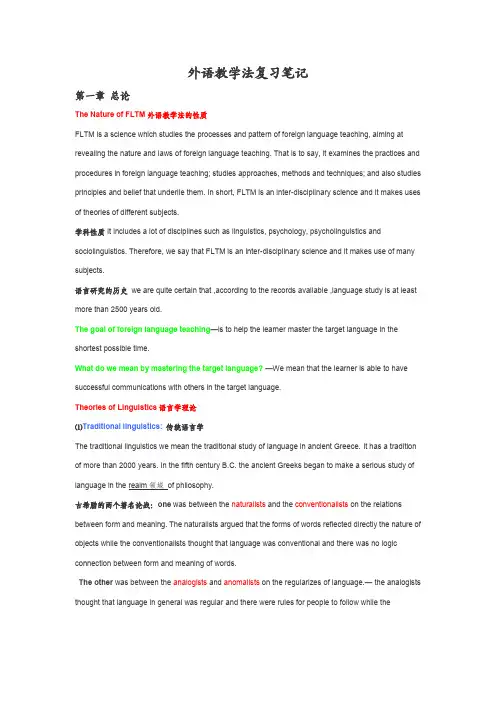
外语教学法复习笔记第一章总论The Nature of FLTM外语教学法的性质FLTM is a science which studies the processes and pattern of foreign language teaching, aiming at revealing the nature and laws of foreign language teaching. That is to say, it examines the practices and procedures in foreign language teaching; studies approaches, methods and techniques; and also studies principles and belief that underlie them. In short, FLTM is an inter-disciplinary science and it makes uses of theories of different subjects.学科性质It includes a lot of disciplines such as linguistics, psychology, psycholinguistics and sociolinguistics. Therefore, we say that FLTM is an inter-disciplinary science and it makes use of many subjects.语言研究的历史we are quite certain that ,according to the records available ,language study is at least more than 2500 years old.The goal of foreign language teaching—is to help the learner master the target language in the shortest possible time.What do we mean by mastering the target language? —We mean that the learner is able to have successful communications with others in the target language.Theories of Linguistics语言学理论⑪Traditional linguistics: 传统语言学The traditional linguistics we mean the traditional study of language in ancient Greece. It has a tradition of more than 2000 years. In the fifth century B.C. the ancient Greeks began to make a serious study of language in the realm领域of philosophy.古希腊的两个著名论战:one was between the naturalists and the conventionalists on the relations between form and meaning. The naturalists argued that the forms of words reflected directly the nature of objects while the conventionalists thought that language was conventional and there was no logic connection between form and meaning of words.The other was between the analogists and anomalists on the regularizes of language.— the analogists thought that language in general was regular and there were rules for people to follow while theanomalists thought that language was basically irregular and that was why there were so many exception and irregularities in the Greek language.Natural of traditional linguistics传统语言学的特征:Traditional linguistics was practical in nature. People made a study of language in order to understand the classic words of ancient times and to teach students. They gave priority to the written form and used words as their starting point. They often took a prescriptive approach when they discussed rules of language.⑫American structuralism 美国结构主义It started at the beginning of the 20th century in America. It became popular and influential in the 1930s and 40s through the world. The two forerunners of structuralism— Franz Boas and Edward Sapir. Franz Boas found that the traditional grammatical model could not be used to analyse the structures of those languages. Sapir found that although Indians’ languages had no written forms, they were very systematic and were very efficient in communications within their communities. The father of American structuralism — Leonard Bloomfield. He accepted the theories and principles of behaviourism. He characterized language and language acquisition in terms of behaviourist terminology. He thought language was a habit of verbal behaviour which consisted of a series of stimuli and responses. He argued that to acquire a language was to form a habit of verbal behaviour and learning a second language was learning a new habit. He thought that speech was primary and writing was secondary.⑬Transformational generative linguistics 转换生成语言学The transformational generative linguistics was first put forward by Noam Chomsky in 1957. He wrote a book Syntactic Structures to spread his theory. His main points---Chomsky assumes that children are born with a language acquisition device(LAD). This LAD is made up of general principles called universal grammar. Once the child is born, the particular language environment will trigger the LAD. The child will use and test the principles again and again until his hypothesis agree with the actual grammar of the language. Chomsky has also made the distinction between the linguistic competence and linguistic performance. ⑭linguistic competence refers to the internalized knowledge that at native speaker of that language processes. Linguistic performance refers to the actual utterance produced by the native speakers. Chomsky believes that linguistics should study the linguistic competence, not the performance, of the native speaker so as to set up a system of rules that will generate an infinite number of grammatical sentences. In order to gain the goal, Chomsky argues that we should use a deductive, hypothesis-testing approach should be used.⑭Functional Linguistics 功能语言学It develops from the London School of linguistics and the precursor of it was Bronislaw Malinowski. Malinowski’s conclusion is that ―the meaning of any single word is to a very hign degree dependent on its context.‖ And an utt erances has no meaning at all if it is out of the context of situation. It was Malinowski who created the phrase ―context of situation‖. J.R.Firth, a linguist, approached the context of situation from a different point of view. He accepted Malinowski’s vie w and he thought the meaning of linguistic items depends on the context of situation. Firth’s main approach to the notion of function in context was by means of concept system. He believes any linguistic item has got two sets of context: the context of the other possible choices in a system and the context where the system itself occurs. People refer to his theory as system-structure theory. Halliday developed Firth’s theory of systemic linguistics and made progress in the study of context. He thought linguistic events should be accounted for at three primary levels: substance, form and context. The substance is the material of language which can be phonic or grahic. The form is the organization of the substance into meaningful events. The context is the relation of the form to non-linguistic features of the situations in which the language operates, and the relation of form to linguistic features other than those of the item under attention. He also said that language has formal meaning and contextual meaning. The formal meaning of a linguistic item is its operation in the network of formal relations. The contextual meaning of an item refers to its relation to extra features, i.e. the context. Halliday thought a particular situation type consists of three dimensions: the ongoing social activity, the role relationship involved, and the sysbolic or rhetorical channel. He called these three dimensions ―field‖, ―tenor‖,and ―mode‖. He believes that there is a systematic relationship between the context and the text.Theories of Psychology心理学理论The first laboratory of experimental psychology was set up at the University of Leipzig, Germany, in 1879. It announced the official birth of psychology. It was opened by Willhelm Wundt.第一个心理实验室建立⑪Gestalt psychology 格式塔心理学It was founded by a group of German psychologists in the 1920s. Their research was focused on the area of perception, aiming at the study of the relationship between parts and whole in people’s perception experience. They found that people perceived objects and scenes as organized wholes before they noticed their component pars. They used the word Gestalt, which means ― organized shape ” or “whole form‖ in English, to name their school of psychology They argued that an object was not the sum of theindividual parts. For example, an article is not the sum of individual words that make up the article. So people’s mind should be understood in terms of a whole.⑫ Psychoanalysis精神分析法It is theory of the mind put forward by Sigmund Freud. Freud found that many of his patients’ mental problems were caused by some disturbing events in their childhood. But the patients could not remember these disturbing events. The part of the mind which is out of the reach of consciousness was called by Freud the subconscious mind, Which was the most important concept in psychoanalysis. Freud divided the mind into conscious and unconscious mind and he was the first to study unconscious mind. Freud believed the contents of the unconscious mind consist of buried memories and instinctive wishes and will influence the activities of the conscious mind. The basic approach of Freud was to analyse the irrational behaviour of the patients, including their dreams and slips of the tongue.⑬ Behaviorism 行为主义In 1913, the American psychologist John B. Watson publish ed an article ― Psychology as the Behaviorist Views it ‖. The article was regarded as a formal introduction to behaviorism. Watson did a lot of experiments with nonhum an animals and animal’s behaviors without any consideration of the animal’s mind. The goal of psychology set out in his articles was to understand the environmental conditions that would cause an animal to behave in a particular way. According to Watson, there was no fundamental difference between human behavior and that of other animals. Wats on’s ideas were accepted by many psychologists. The dominant position of behaviorism was maintained until the mid-1960s.The leader of behaviorism was Skinner.He developed a new kind of apparatus for studying learning in animals and a new way of describing the learning process. Watson’s t heory is called classic behaviorism while Skinner’s theory is called neo-behaviorism. The early behaviorists focused the attention on the topic of learning and they tried to characterize learning in terms of stimuli and response. Stimuli are observable events in the world that affect behavior and responses are observable behavioral acts. Skinner argued that learning process could be divided into two kinds: classical conditioning and operant conditioning. In classical conditioning a stimulus that did not elicit a response comes to elicit a response. By operant conditioning the occurrence of a response will be determined by the consequences of the response. For example, we look up a word in a dictionary because we can find out the meaning of the word in it.⑭ Cognitive psychology认知心理学The term cognition means knowledge and cognitive psychology can be defined as the study of people’s ability to acquire, organize, remember and use knowledge to guide their behavior. The most important factor that has made cognitive psychology the dominant approach is the development of the computer technology. The brain works in a similar way to process information. The brain receives information through senses, processes it and sends it out as behavior actions.The American linguist Noam Chomsky greatly influenced cognitive psychology. In his book Syntax Structure (1957) Chomsky argued that language should be viewed as a system of mental rules which are wired into the brain as a result of evolution. Cognitive psychologists maintain that all the relationship among stimuli, responses and consequences are learned and are integrated into the animal’s knowledge.There are two principal types of cognitive structures—schemas and concepts. Schemas refer to sets of rules that define particular categories of behavior. Concepts are rules that describe properties of events and their relation with one another. 认知结构主要分为两种——schemas图式and concepts概念。
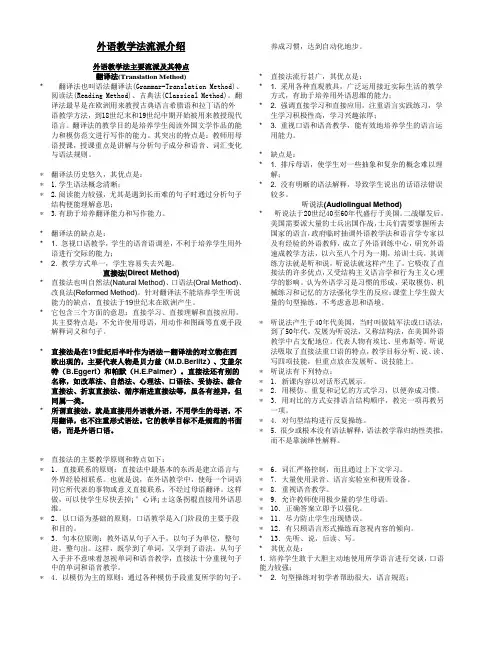
外语教学法流派介绍外语教学法主要流派及其特点翻译法(T r a n s l a t i o n M e t h o d)* 翻译法也叫语法翻译法(Grammar-Translation Method)、阅读法(Reading Method)、古典法(Classical Method)。
翻译法最早是在欧洲用来教授古典语言希腊语和拉丁语的外语教学方法,到18世纪末和19世纪中期开始被用来教授现代语言。
翻译法的教学目的是培养学生阅读外国文学作品的能力和模仿范文进行写作的能力。
其突出的特点是:教师用母语授课,授课重点是讲解与分析句子成分和语音、词汇变化与语法规则。
*翻译法历史悠久,其优点是:* 1.学生语法概念清晰;* 2.阅读能力较强,尤其是遇到长而难的句子时通过分析句子结构便能理解意思;* 3.有助于培养翻译能力和写作能力。
* 翻译法的缺点是:* 1. 忽视口语教学,学生的语音语调差,不利于培养学生用外语进行交际的能力;* 2. 教学方式单一,学生容易失去兴趣。
直接法(D i r e c t M e t h o d)* 直接法也叫自然法(Natural Method)、口语法(Oral Method)、改良法(Reformed Method)。
针对翻译法不能培养学生听说能力的缺点,直接法于19世纪末在欧洲产生。
* 它包含三个方面的意思:直接学习、直接理解和直接应用。
其主要特点是:不允许使用母语,用动作和图画等直观手段解释词义和句子。
* 直接法是在19世纪后半叶作为语法-翻译法的对立物在西欧出现的,主要代表人物是贝力兹(M.D.Berlitz)、艾盖尔特(B.Eggert)和帕默(H.E.Palmer)。
直接法还有别的名称,如改革法、自然法、心理法、口语法、妥协法、综合直接法、折衷直接法、循序渐进直接法等,虽各有差异,但同属一类。
* 所谓直接法,就是直接用外语教外语,不用学生的母语,不用翻译,也不注重形式语法。
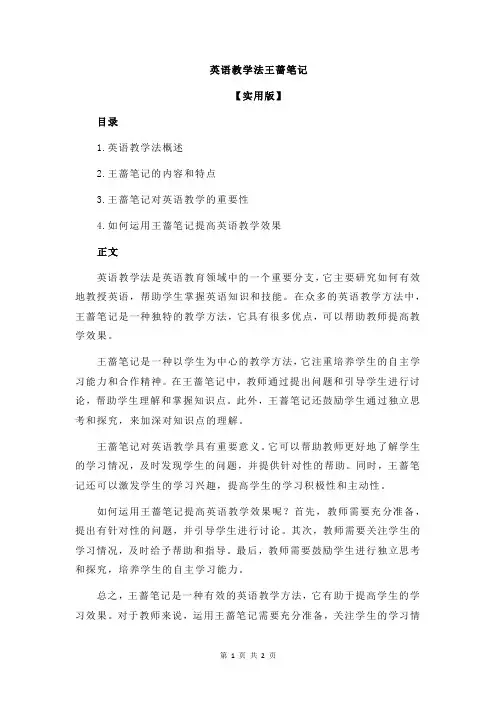
英语教学法王蔷笔记
【实用版】
目录
1.英语教学法概述
2.王蔷笔记的内容和特点
3.王蔷笔记对英语教学的重要性
4.如何运用王蔷笔记提高英语教学效果
正文
英语教学法是英语教育领域中的一个重要分支,它主要研究如何有效地教授英语,帮助学生掌握英语知识和技能。
在众多的英语教学方法中,王蔷笔记是一种独特的教学方法,它具有很多优点,可以帮助教师提高教学效果。
王蔷笔记是一种以学生为中心的教学方法,它注重培养学生的自主学习能力和合作精神。
在王蔷笔记中,教师通过提出问题和引导学生进行讨论,帮助学生理解和掌握知识点。
此外,王蔷笔记还鼓励学生通过独立思考和探究,来加深对知识点的理解。
王蔷笔记对英语教学具有重要意义。
它可以帮助教师更好地了解学生的学习情况,及时发现学生的问题,并提供针对性的帮助。
同时,王蔷笔记还可以激发学生的学习兴趣,提高学生的学习积极性和主动性。
如何运用王蔷笔记提高英语教学效果呢?首先,教师需要充分准备,提出有针对性的问题,并引导学生进行讨论。
其次,教师需要关注学生的学习情况,及时给予帮助和指导。
最后,教师需要鼓励学生进行独立思考和探究,培养学生的自主学习能力。
总之,王蔷笔记是一种有效的英语教学方法,它有助于提高学生的学习效果。
对于教师来说,运用王蔷笔记需要充分准备,关注学生的学习情
况,并鼓励学生进行独立思考和探究。
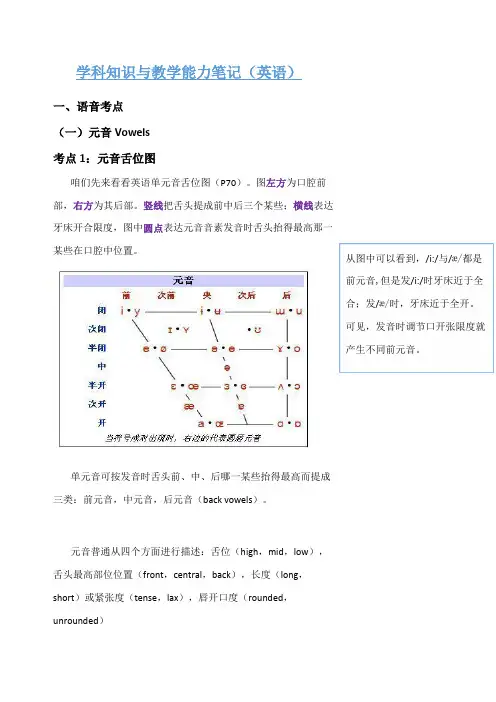
学科知识与教学能力笔记(英语)一、语音考点(一)元音Vowels考点1:元音舌位图咱们先来看看英语单元音舌位图(P70)。
图左方为口腔前部,右方为其后部。
竖线把舌头提成前中后三个某些;横线表达牙床开合限度,图中圆点表达元音音素发音时舌头抬得最高那一某些在口腔中位置。
单元音可按发音时舌头前、中、后哪一某些抬得最高而提成三类:前元音,中元音,后元音(back vowels)。
元音普通从四个方面进行描述:舌位(high,mid,low),舌头最高部位位置(front,central,back),长度(long,short)或紧张度(tense,lax),唇开口度(rounded,unrounded)从图中可以看到,/i:/与/æ/都是前元音,但是发/i:/时牙床近于全合;发/æ/时,牙床近于全开。
可见,发音时调节口开张限度就产生不同前元音。
音标描述汇总:[i:] h igh front tense unrounded vowel [І] high front lax unrounded vowel [u:] high back tense rounded vowel [ʊ]即[u] high back lax rounded vowel [З:]或[ə:] central tense unrounded vowel [ə] central lax unrounded vowel[e] mid-high front lax unrounded vowel [æ] low front lax unrounded vowel[Λ] mid-low back lax unrounded vowel [ɔ:] mid-low back tense rounded vowel [ɒ] low back lax rounded vowel[ɑ:] low back tense unrounded vowel考点2:专有名词基本元音Cardinal Vowels纯元音Pure Vowels/单元音Monophthong Vowels滑元音Vowels glides:There is an audible change of quality. ——If a single movement of the tongue is involved,the glides are called双元音Diphthongs如:[eI] from mid-low front to high front[aI] [ɔI] [əʊ] [aʊ] [Iə] [eə] [ʊə] 略A double movement produces 三元音Triphthong例如:tower 中[aʊə](二)辅音ConsonantsConsonants are sounds produced by constricting or obstructing the vocal tract at some place to divert ,impede or completely shut off the flow of air in the oral cavity.Vowels 元音:produced without such obstruction so no turbulence or a total stopping of the air can be perceived.区别:the distinction between vowels and consonants lies in the obstruction of airstream.阻塞气流。
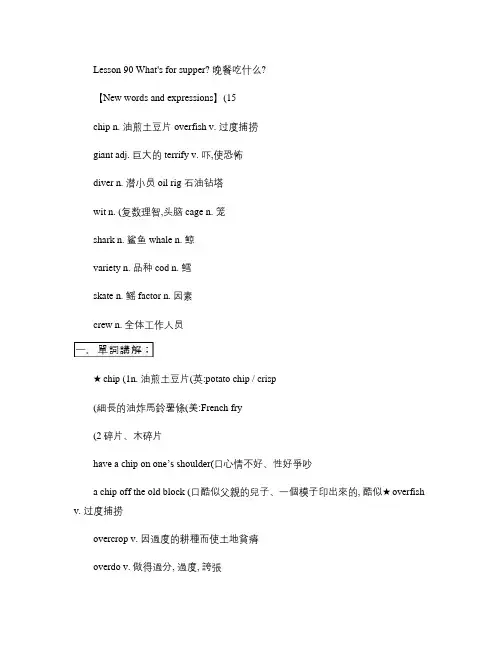
Lesson 90 What's for supper? 晚餐吃什么?【New words and expressions】(15chip n. 油煎土豆片overfish v. 过度捕捞giant adj. 巨大的terrify v. 吓,使恐怖diver n. 潜小员oil rig 石油钻塔wit n. (复数理智,头脑cage n. 笼shark n. 鲨鱼whale n. 鲸variety n. 品种cod n. 鳕skate n. 鳐factor n. 因素crew n. 全体工作人员★chip (1n. 油煎土豆片(英:potato chip / crisp(細長的油炸馬鈴薯條(美:French fry(2碎片、木碎片have a chip on one’s shoulder(口心情不好、性好爭吵a chip off the old block (口酷似父親的兒子、一個模子印出來的, 酷似★overfish v. 过度捕捞overcrop v. 因過度的耕種而使土地貧瘠overdo v. 做得過分, 過度, 誇張overdraw vt. 透支, 拉過度, 誇大overdress v. (使過度打扮, 穿著太考究overeat 食べ過ぎる、vi. 吃過量★giant (1adj. 巨大的a giant corporation 一個大公司giant panda n. 大貓熊, 大熊貓(2n. (故事或傳說等巨人、大漢(相反:dwarf 矮子eg:Jack saw the giant climbing down the beanstalk .傑克看到巨人爬下豆莖。
(3n. 偉人、大人物giants in the field of electronics 電子行業之牛耳.★terrify v. 吓,使恐怖、使受驚嚇be terrified of 害怕 ..., 恐懼 ...eg:The children were terrified of being scolded . 孩子們害怕被罵。
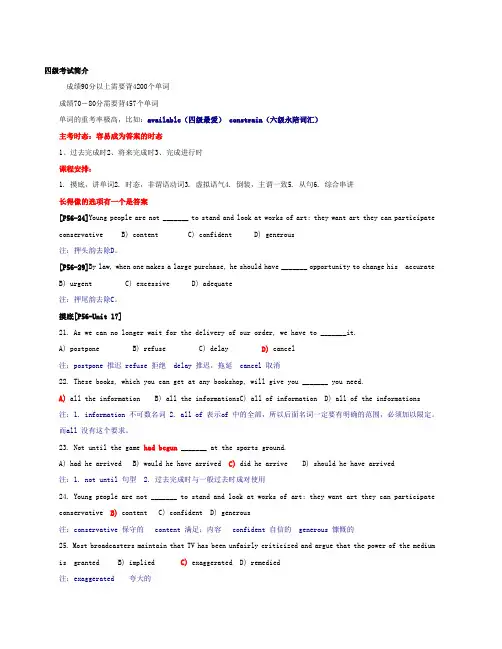
四级考试简介成绩90分以上需要背4200个单词成绩70-80分需要背457个单词单词的重考率极高,比如:available(四级最爱) constrain(六级永陪词汇)主考时态:容易成为答案的时态1、过去完成时2、将来完成时3、完成进行时课程安排:1. 摸底,讲单词2. 时态,非谓语动词3. 虚拟语气4. 倒装,主谓一致5. 从句6. 综合串讲长得像的选项有一个是答案[P56-24]Young people are not _______ to stand and look at works of art; they want art they can participate conservative B) content C) confident D) generous注:押头韵去除D。
[P56-29]By law, when one makes a large purchase, he should have _______ opportunity to change his accurateB) urgent C) excessive D) adequate注:押尾韵去除C。
摸底[P56-Unit 17]21. As we can no longer wait for the delivery of our order, we have to _______it.A) postpone B) refuse C) delay D) cancel注:postpone 推迟 refuse 拒绝 delay 推迟,拖延 cancel 取消22. These books, which you can get at any bookshop, will give you _______ you need.A) all the information B) all the informationsC) all of information D) all of the informations注:1. information 不可数名词 2. all of 表示of 中的全部,所以后面名词一定要有明确的范围,必须加以限定。
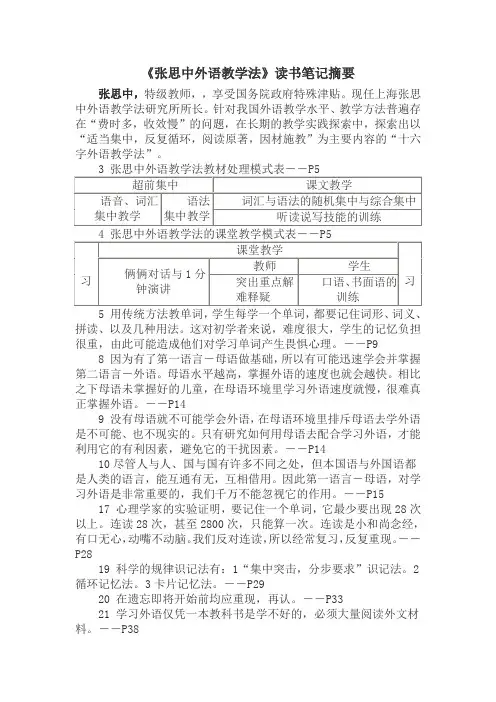
《张思中外语教学法》读书笔记摘要张思中,特级教师,,享受国务院政府特殊津贴。
现任上海张思中外语教学法研究所所长。
针对我国外语教学水平、教学方法普遍存在“费时多,收效慢”的问题,在长期的教学实践探索中,探索出以“适当集中,反复循环,阅读原著,因材施教”为主要内容的“十六字外语教学法”。
5 用传统方法教单词,学生每学一个单词,都要记住词形、词义、拼读、以及几种用法。
这对初学者来说,难度很大,学生的记忆负担很重,由此可能造成他们对学习单词产生畏惧心理。
――P98 因为有了第一语言-母语做基础,所以有可能迅速学会并掌握第二语言-外语。
母语水平越高,掌握外语的速度也就会越快。
相比之下母语未掌握好的儿童,在母语环境里学习外语速度就慢,很难真正掌握外语。
――P149 没有母语就不可能学会外语,在母语环境里排斥母语去学外语是不可能、也不现实的。
只有研究如何用母语去配合学习外语,才能利用它的有利因素,避免它的干扰因素。
――P1410尽管人与人、国与国有许多不同之处,但本国语与外国语都是人类的语言,能互通有无,互相借用。
因此第一语言-母语,对学习外语是非常重要的,我们千万不能忽视它的作用。
――P1517 心理学家的实验证明,要记住一个单词,它最少要出现28次以上。
连读28次,甚至2800次,只能算一次。
连读是小和尚念经,有口无心,动嘴不动脑。
我们反对连读,所以经常复习,反复重现。
――P2819 科学的规律识记法有:1“集中突击,分步要求”识记法。
2循环记忆法。
3卡片记忆法。
――P2920 在遗忘即将开始前均应重现,再认。
――P3321 学习外语仅凭一本教科书是学不好的,必须大量阅读外文材料。
――P3824 突破难点是形成心理优势的关键,排除干扰是形成、保持与发展心理优势的保证,满足各种水平学生的要求是形成、保持与发展心理优势的动力,看到成就是形成、保持与发展心理优势的强化剂。
――P211-214。
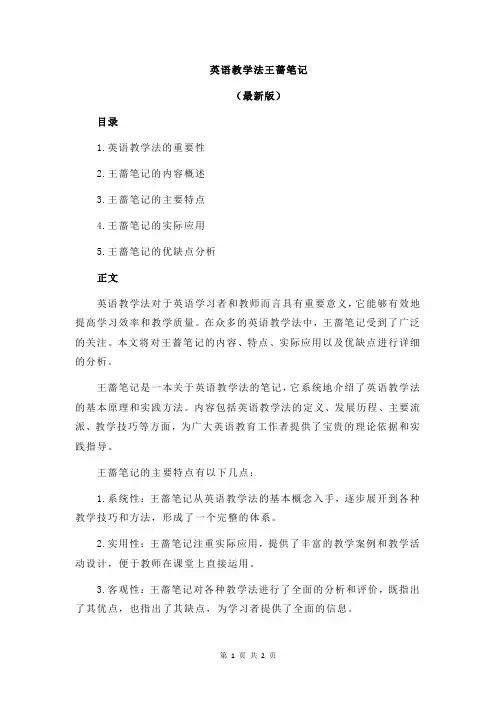
英语教学法王蔷笔记(最新版)目录1.英语教学法的重要性2.王蔷笔记的内容概述3.王蔷笔记的主要特点4.王蔷笔记的实际应用5.王蔷笔记的优缺点分析正文英语教学法对于英语学习者和教师而言具有重要意义,它能够有效地提高学习效率和教学质量。
在众多的英语教学法中,王蔷笔记受到了广泛的关注。
本文将对王蔷笔记的内容、特点、实际应用以及优缺点进行详细的分析。
王蔷笔记是一本关于英语教学法的笔记,它系统地介绍了英语教学法的基本原理和实践方法。
内容包括英语教学法的定义、发展历程、主要流派、教学技巧等方面,为广大英语教育工作者提供了宝贵的理论依据和实践指导。
王蔷笔记的主要特点有以下几点:1.系统性:王蔷笔记从英语教学法的基本概念入手,逐步展开到各种教学技巧和方法,形成了一个完整的体系。
2.实用性:王蔷笔记注重实际应用,提供了丰富的教学案例和教学活动设计,便于教师在课堂上直接运用。
3.客观性:王蔷笔记对各种教学法进行了全面的分析和评价,既指出了其优点,也指出了其缺点,为学习者提供了全面的信息。
4.创新性:王蔷笔记在总结传统教学法的基础上,也介绍了一些新的教学理念和方法,如任务型教学法、合作学习等,为英语教学注入了新的活力。
王蔷笔记在实际应用中取得了显著的效果,许多英语教师在教学中采用了王蔷笔记推荐的教学法,提高了教学质量。
同时,学习者通过学习王蔷笔记,也能够更好地掌握英语学习方法和技巧,提高学习效果。
然而,王蔷笔记也存在一些优缺点。
优点在于其系统性强、实用性高,能够为英语教学提供全面的指导。
缺点在于部分内容较为理论化,对于初学者而言可能较难理解。
此外,王蔷笔记介绍的教学法并非都适用于所有情况,教师需要根据实际情况灵活运用。
总之,王蔷笔记是一本具有重要参考价值的英语教学法笔记,对于英语教育工作者和学习者都具有较高的实用价值。
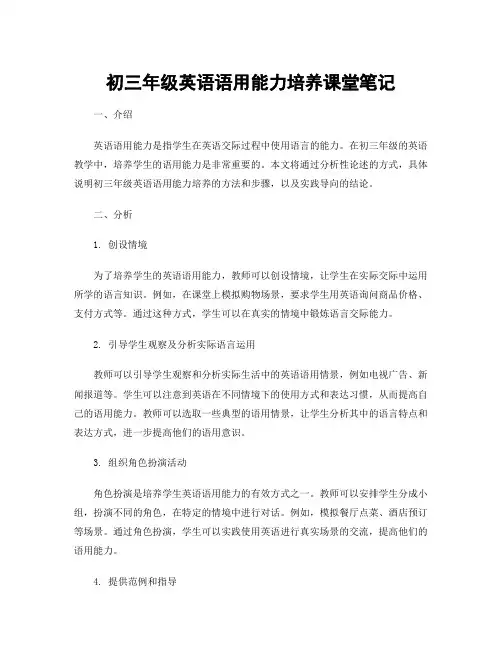
初三年级英语语用能力培养课堂笔记一、介绍英语语用能力是指学生在英语交际过程中使用语言的能力。
在初三年级的英语教学中,培养学生的语用能力是非常重要的。
本文将通过分析性论述的方式,具体说明初三年级英语语用能力培养的方法和步骤,以及实践导向的结论。
二、分析1. 创设情境为了培养学生的英语语用能力,教师可以创设情境,让学生在实际交际中运用所学的语言知识。
例如,在课堂上模拟购物场景,要求学生用英语询问商品价格、支付方式等。
通过这种方式,学生可以在真实的情境中锻炼语言交际能力。
2. 引导学生观察及分析实际语言运用教师可以引导学生观察和分析实际生活中的英语语用情景,例如电视广告、新闻报道等。
学生可以注意到英语在不同情境下的使用方式和表达习惯,从而提高自己的语用能力。
教师可以选取一些典型的语用情景,让学生分析其中的语言特点和表达方式,进一步提高他们的语用意识。
3. 组织角色扮演活动角色扮演是培养学生英语语用能力的有效方式之一。
教师可以安排学生分成小组,扮演不同的角色,在特定的情境中进行对话。
例如,模拟餐厅点菜、酒店预订等场景。
通过角色扮演,学生可以实践使用英语进行真实场景的交流,提高他们的语用能力。
4. 提供范例和指导在培养学生英语语用能力的过程中,教师可以提供一些范例和指导,帮助学生正确使用语言。
例如,教师可以给学生提供一些常用的交际用语,让他们学会在特定情境下用英语表达自己的需求和意见。
同时,教师还可以指导学生如何运用语法知识来实现语用目标,例如使用不同的时态来表示不同的意思。
三、实践导向结论通过以上的方法和步骤,初三年级的英语教师可以有效地培养学生的语用能力。
创设情境、引导观察分析、组织角色扮演活动和提供范例指导是培养学生英语语用能力的关键步骤。
通过实践操作和反复练习,学生可以逐渐掌握英语表达的技巧和习惯,提高他们的语用能力。
四、问题进一步阐释在初三年级英语语用能力培养中,可能会遇到一些问题。
例如,学生在使用英语时可能会出现词汇量不足、语法错误、语音不准确等问题。
作业1.第1题The ___ theory believes that learning is a process in which the learner constructsmeaning based on his/her own experiences and what he or she alreadyknows.您的答案:A题目分数:此题得分:2.第2题According to Ur (1996), as for the useof grammatical terminology, foryounger learners, use of complex terminology ___.be usedbe avoidednecessaryhelpful您的答案:B题目分数:此题得分:3.第3题Examples of pronunciation perception practice include ___.pictures and tongue twistersminimal pairs, and “odd one out”and discussionof the above题目分数:此题得分:4.第4题As far as language learning is concerned, the ___emphasize the nature of the human and physical context in which language learning takes place, such as the number of students, the kind of input learners receive, and the atmosphere. theoriestheoriestheoriestheories您的答案:A题目分数:此题得分:5.第5题As far as learning pronunciation is concerned, the realistic goals for the students are consistency, intelligibility, and ___.efficiency您的答案:A题目分数:此题得分:6.第6题According to Ellis, procedures for teaching grammar using listening as input are “Listening to comprehend”, “Listening to notice”, “Understanding the grammar point”, ___.A.“listen and repeat” and “listen and tick”B. “checking” and “trying it out”C.“listen and circle” and “listen and write”D.“listen and correct” and “listen and fill”您的答案:B此题得分:7.第7题When we are teaching pronunciation, we should not lead students to focus on reading and writing phonetic transcripts of words, especially young students, because phonetic transcripts are ___.easy to learnhard to remember for young learnershard to write for young learnersabstract and less meaningful than sounds您的答案:D题目分数:此题得分:8.第8题The goal of Communicative Efficiency means that the pronunciation should ___. accuratesmooth and naturalnative-likeconvey the meaning intended by the speaker您的答案:D题目分数:此题得分:9.第9题The three aspects of pronunciation are ___ each other. They are interrelated. united withisolated fromwithto您的答案:B题目分数:此题得分:10.第10题Communicative language teaching (clt) has expanded the areas covered by theprevious approaches or methodologies, that is, clt covers language content (to incorporate functions), ___ (cognitive style and information processing), and product (language skills).processmethods您的答案:A题目分数:此题得分:11.第11题When practising individual sounds, it is important to remember that such ear training activities are actually ___ for helping learners improve their communicative listening or speaking.sufficientnecessaryhelpful您的答案:B题目分数:此题得分:12.第12题To help our students pass exams is one of the purposes of our English teaching. Another purpose, which is very important, is to prepare our students to ___.A.useenglish in real lifeknowledge about languageup sentencesa good job in the future您的答案:A题目分数:此题得分:13.第13题According to Wang Qiang, the way a language teacher learned a language willinfluence the way he ____ to some extent.a languagea languagehis mother tonguelinguistic knowledge您的答案:B题目分数:此题得分:14.第14题According to Wang Qiang, two questions that views on language learning involve are “what ar e the psycholinguistic and cognitive processes of language learning” and “____”are the conditions for the learning processes to be activateddo people imitate others when they are learning a languageis languagedo people learn linguistic structures您的答案:A题目分数:此题得分:15.第15题Communicative competence consists of knowledge and ability for___.of rules of pronunciation, vocabulary and grammarof grammar/form and rules of language use, words, and grammarand writing您的答案:B题目分数:此题得分:16.第16题The ultimate goal of foreign language teaching is to enable students to usethe foreign language in work or life when necessary. thus we should teach ___; and we should teach language in the way it is used in the real world.part of the language that will be usedparts of the languagelanguage used in works of classical literaturelanguage only您的答案:A题目分数:此题得分:17.第17题<p><span style=font-family: lang=EN-US new= times=>Ways of consolidating new words suggested in Wang Qiang’s book (2000) include the following EXCEPT___.</span></p>objects in a picturethe differences in two picturesa game of “What did you see just now”the words in chorus您的答案:D题目分数:此题得分:18.第18题When teaching pronunciation, great care should be taken to the distinction between ___.and grammarand vocabularyand writingand phonetics您的答案:D题目分数:此题得分:19.第19题PPP and TBL are two approaches to language teaching. PPP stands for presentation, practice and production, and TBL stands for___.Book Language standsBook LearningLearningLearning您的答案:D题目分数:此题得分:20.第20题According to Wang Qiang, some people regard teaching as ____, while others regard it as____.craft; an applied scienceprofession; an interesttheory; a practicelearning; language training您的答案:A题目分数:此题得分:21.第21题It is believed that the inductive method is more effective than the deductive method because students ___ while engaged in language use.told the grammar rules by the teacherthe grammar rules without any difficultythe grammar rules themselveslearn the grammar rules您的答案:C题目分数:此题得分:22.第22题One language form may express a number of communicative functions and one ___ can also be expressed by a variety of ___.… dia lects… languagesform … communicative functionsfunction … language forms您的答案:D题目分数:此题得分:23.第23题According to Nation (2001) productive knowledge of vocabulary involves the following except ___.(1) being able to say it with correct pronunciation and stress(2) being able to produce words that commonly occur with it(3) being able to recognize the typical collocations(4) being able to produce synonyms and opposites for itA.(1)B.(2)C.(3)D.(4)您的答案:D题目分数:此题得分:24.第24题According to littlewood (1981), identifying pictures, discovering sequences or locations, discovering differences and reconstructing story-sequences are examples of ___.practicelanguagecommunicative activitiesinteraction activities您的答案:C题目分数:此题得分:25.第25题One of the reasons why the deductive method of teaching grammar is criticized is that ___ in the method.is taught in an isolated wayattention is paid to meaningpractice is often meaningfuldo not benefit from the method at all您的答案:C题目分数:此题得分:26.第26题The deductive method of teaching grammar relies on ___.devotion, professional qualities, and personal style, imitating and practising, analysing and comparing, reading and writing您的答案:C题目分数:此题得分:27.第27题When teaching vocabulary, the teacher can ___ to promote high motivation.rote learningthe words from the contextthe students’ learning processnewly learned language to students’ real life您的答案:D题目分数:此题得分:28.第28题According to Wallace, the development of a teacher consists of three stages. a teacher begins his language training in Stage 1, and acquires his ____ at Stage 3. competencecompetenceexperienceknowledge您的答案:B题目分数:此题得分:29.第29题The ___ sees languages not only as a linguistic system but also as a means for doing things.viewviewviewview您的答案:B题目分数:此题得分:30.第30题Adjectives such as 'well-informed', 'resourceful', and 'reflective' can be used to describe a teacher’s ___, one of the three elements of a goo d foreign language teacher.devotionqualitystyleproficiency您的答案:A题目分数:此题得分:31.第31题The teaching of pronunciation should focus on the students’ ability to identify and produce english ___ themselves.transcripts您的答案:A题目分数:此题得分:32.第32题One of the reasons why the deductive method is criticized is that ___ in themethod.is taught in a contextattention is paid to meaningpractice is often mechanicalenough explanation is provided您的答案:C题目分数:此题得分:33.第33题Hedge discusses five main components of communicative competence. these components inlude linguistic competence, pragmatic competence, discourse competence, strategic competence, and ___.您的答案:B题目分数:此题得分:34.第34题Accuracy in pronunciation is often done at the expense of ___. Speech produced in this way is not only unnatural but also uncomfortable to hear.efficiency您的答案:A题目分数:此题得分:35.第35题According to some scholars Task-based Language Teaching is, in fact, ___ Communicative Language Teaching.the same asfurther development oftoto do with您的答案:B题目分数:此题得分:36.第36题___ is used by native speakers to express meanings in many subtle ways such as surprise, complaint, sarcasm, friendliness, threats, etc.您的答案:B题目分数:此题得分:37.第37题A teacher writes on the blackboard: “7 o’clock – got up – had breakfast – hurried to school – school closed – surprised –”, and asks the students to usethese words to tell a story. the teacher is making the students practise grammar by using ___ for story telling.phrasesaction您的答案:C题目分数:此题得分:38.第38题According to Wang Qiang, one question that all approaches of language teaching should answer is “___”is a mother tongueis a second/foreign languageis Englishis language您的答案:D题目分数:此题得分:39.第39题Two theories concerning language learning are the ____.theories and the notional theoriestheories and the behavioural theoriestheories and the interactional theoriestheories and the condition-oriented theories您的答案:D题目分数:此题得分:40.第40题Those words that one is not only able to recognize but also able to usein speech and writing are considered as one’s ___.or activeor passiveor passiveor active您的答案:D题目分数:此题得分:41.第41题One ineffective way of learning vocabulary, which often occurs when students study vocabulary individually is ___ learning.您的答案:A题目分数:此题得分:42.第42题The guided discovery method is similar to the inductive method because the students ___.told rules by the teacher at the beginninginduced to discover rules by themselvesgrammar analysis by themselvesknow the rules您的答案:B题目分数:此题得分:43.第43题According to Pennington (2002), useful guidelines for teaching grammar include collocational, constructive, contextual, and ___.您的答案:C题目分数:此题得分:44.第44题<p><span style=font-family: times= new= lang=EN-US>Ways of consolidating new words suggested in Wang Qiang’s book (2000) include the following EXCEPT___.</span></p>the wordsword net-workcategoriesthe Internet resources for more ideas您的答案:A题目分数:此题得分:45.第45题The goal of Intelligibility means that the pronunciation should be ___.and natural您的答案:D题目分数:此题得分:46.第46题According to Ur (1996), a good presentation should include both oral and written, and both ___.and writingand readingand grammarand meaning您的答案:D题目分数:此题得分:47.第47题“Try to provide a visual or physical demonstration whenever possible, using ___ to show meaning” is on e of the ways of presenting new words suggested in Wang Wiang’s book (2005).verbal contextsets or hyponyms, photos, video clips, mime or gesturesformation rules and common affixes您的答案:C题目分数:此题得分:48.第48题Jane Willis holds that the conditions for language learning are exposure to a rich but comprehensible language put, ___ of the language to do things, motivation to process and usethe exposure, and instruction in language.B.use您的答案:B题目分数:此题得分:49.第49题The ___ of language sees language as a linguistic system made up of various subsystems: the sound system (phonology), the discrete units of meaning produced by sound combinations (morphology), and the system of combining units of meaning for communication (syntax).viewviewviewview您的答案:A题目分数:此题得分:50.第50题Which of the following is NOT among Ellis’ (1990) six criteria for evaluating how communicative classroom activities arepurposedesirematerial controlintervention您的答案:C题目分数:此题得分:作业总得分:作业总批注:。
第一次IBT考试成绩阅读,听力,口语和作文分别8,15,18和20第二次的考试分别是24,28,20和25。
首先我想先说明一下我第一次考试时候的水平:上海高考英语123分(我想,如果你是在117-127左右的话,那我的心得还是很有价值的)第一:绝对绝对要背单词!第一次我以为不需要也能够理解文章的意思,只要能够联系上下文或者猜测就可以,可是事实是我的阅读成绩只有个位数,这是就是我不背单词最直接的报应,罪有应得就是讲的这个!于是第二次准备的时候,我很认真地把王玉梅的词汇书翻了好几遍,如果觉得按照LIST的效果不好(因为很容易产生疲惫感,而且单词太相似会背串),那么就以你以随手翻到的页数进行背记,这样比较有新鲜感。
在记忆的同时,把有意义的,觉得在作文中可能用到的单词,借助词典,抄录并整理经典例句以备后用。
通过背单词,阅读的能力可以得到显著的提高(虽然在考试中体会不明显,但是分数是明显的-_-b),背单词的过程中会出现很多生涩的专业词汇,听力中很有可能会遇到,如果准备了,那便是万幸;写作就更不用说,能够好几层次地提高文采。
第二:DELTA和阅读和口语要好好做,LONGMAN的考试技巧一章节好好消化,官方指南的听力好好听!我的备考过程中,一直都是在用DELTA,而且深感它对我的帮助。
DELTA的阅读章节里头有很多考试的题型分析以及训练,这是戳到实处的有效练习,在获得技巧的同时,我自身的思维方式渐渐也在升华,更有逻辑;它最后的总测试中的阅读要细心地好好做!当然我也要提到,DELTA里的阅读难度远远不及正式考试,要警戒,但如果你每次的测试都能在30里的27分,那么考试25左右还是能够保证的。
考试的时候,阅读不能图快速,我第一次的时候竟然只用了三十多分钟,文章都没全看!而且第一篇一般都会吓吓人,接下来的就没那么难了。
DELTA的听力,有些太专业化了,比如地质学啊这种科学类的文章,可是事实上考试中很多是文学艺术类的,不要太过担心,但如果科学类的什么都听不懂,也是有问题的,就像我第一次,估计也就15左右。
一.考研阅读的基本解题思路:(四步走)第一,扫描提干,划关键项。
第二,通读全文,抓住中心。
. 通读全文,抓两个重点:①首段(中心句、核心概念常在第一段,常在首段出题);②其他各段的段首和段尾句。
(其他部分略读,有重点的读). 抓住中心,用一分半时间思考个问题:①文章叙述的主要内容是什么?②文章中有无提到核心概念?③作者的大致态度是什么?第三,仔细审题,返回原文。
(仔细看题干,把每道题和原文的某处建立联系,挂起钩)定位原则:①通常是由题干出发,使用寻找关键词定位原则。
(关键词:大写字母、地名、时间、数字等)②自然段定位原则。
出题的顺序与行文的顺序是基本一致的,一般每段对应一题。
★要树立定位意识,每一题、每一选项都要回到原文中某一处定位。
第四,重叠选项,得出答案。
(重叠原文对照原文). 通过题干返回原文:判断四个选项,抓住选项中的关键词,把选项定位到原文的某处比较,重叠选项,选出答案。
.作题练习要求:要有选一个答案的理由和其余三个不选的理由二.阅读理解的解题技巧.例证题:①例证题的标记。
当题干中出现, , , , 时。
②返回原文,找出该例证所在的位置,既给该例子定位。
③搜索该例证周围的区域,向上,向下,找出该例证支持的观点。
例子周围具有概括抽象性的表达通常就是它的论点。
注意:举例的目的是为了支持论点或是为了说明主题句。
举例后马上问这个例子说明了什么问题?不能用例子中的话来回答这个问题。
④找出该论点,并与四个选项比较,得出选项中与该论点最一致的答案。
⑤例证题错误答案设计的干扰特征经常是:就事论事。
? 即用例子中的某一内容拉出来让你去选。
(╳)要求:在阅读中,遇到长的例子,立即给这个例子定位,即找出起始点,从哪开始到哪结束。
.指代题:①返回原文,找出出题的指代词。
②向上搜索,找最近的名词、名词性短语或句子(先从最近点开始找,找不到再找次近的,一般答案不会离得太远)。
③将找到的词、词组或句子的意思代入替换该指代词,看其意思是否通顺。
按照内容分为两类:一、文科文章—两点注意: 1.文章态度 2.抓住文章主题1)把握主题后不会偏差理解2)与主题相关的选项为优选选项二、理科文章1.试验型(Study\Experiment\Research\Test)2.科技成果型(e.g. Artificial Heart)3.现象解释型按照体裁分为三类:一、说明文 1.抓住说明对象 2.重要数据事实二、议论文属于文科类文章三、记叙文阅读中难点句型:一、多重复合句----关键抓住主句主干成分二、多重并列句----两个主句并列在一起,而非主句从句嵌套在一起三、强调句----被强调部分为主语、宾语、状语It is that…四、被动句----基本结构A is done by B五、倒装句----否定词hardly, rarely, seldom, never, not until, not only 引起句子倒装六、省略句----e.g. He is a good man, so am I.建议采用的阅读方法:一、扫描题干,大致了解题目类型及分布,将其中细节题题干关键词划出。
二、速读原文,遇到题干关键词或其同义词时做适当标记;关注考试原则句。
考试原则句:重要句(各段首句,文章末句,结论、解释句),转折句,条件句,因果关系句,复合句等难句(多重复合、多重并列、强调句、倒装句),时间,数字,人名,比较。
三、定位答案,正确选项为文章对应语句的同义改写。
题型攻略:一、主题题(main idea/ mainly/ mainly discuss/mainly concerned/ central/ primary)两种变体:1.写作目的题型purpose of writing2.文章标题题型the best title做题方法:1.找主题句 2.找主体词(通常在文章中出现频率较高,往往会在第一段出现,且带有概括性的词语)二、细节题类型:1.对错题2.例证题 3.一般细节题做题方法:准确定位三、词汇题类型:1.指代题2.词义题做题方法:1.根据上下文关系2.构词法(词根词缀)st(位置不变):st ay--st and--st ationary--st reet--st ar--st atue--st atuspose(放置):pos ition-ex pose (ex向外: exit-export) pro pose (pro向前) sup pose (sup/sub在下面: subway--submarine)de pose (de否定) deposit (de向下) inter pose (inter: internet, international)背单词方法1. 词根词缀2. 阅读记忆3. 联想记忆如:handsome(其中:h很,s帅,m嘛→英俊的)morose(mo没有,rose玫瑰→郁闷的)ancillary(an + cillary希拉里→辅助的)四、推理题(infer-imply-suggest-indicate-conclude)正确答案特点:文章对应内容的同义改写五、作者态度题(attitude-be seen as)做题方法:1.找作者直接评价语句 2.找表达感情色彩的形容词、动词、副词Questions 21 to 25 are based on the following passage:21. The passage implies that the telegraph cable was built mainly _________.A) for oceanographic studies B) for military purposesC) for business consideration s D) for investigating the depths of the oceans22. It was ________ that asked Maury for help in oceanographic studies.A) the American Navy B) some early intercontinental travellersC) those who earned a living from the sea D) the company which proposed to lay an undersea cable23. The aim of voyages Maury encouraged in the 1840s was __________.A) to make some sound experiments in the oceans B) to collect samples of sea plants and animalsC) to estimate the length of cable that was to be made D) to measure the depths of two oceans24. 'Defied'in the 5th paragraph probably means ________A) 'doubted' B) 'gave proof to' C) 'challenged' D) 'agreed to'25. This passage is mainly about _________A) the beginnings of oceanography B) the laying of the first undersea cableC) the investigation of ocean depths D) the early intercontinental communicationsQuestions 21 to 25 are based on the following passage:Oceanography has been defined as 'The application of all sciences to the study of the sea'.注:1.Oceanography 由Ocean (海洋) 和graphy (学科)组成,意为“海洋学”2.application 表示“申请”用介词for,表示“应用”用介词to3.第一句给某个东西下定义,称为篇章定义,必为文章主题Before the nineteenth century, scientists with an interest in the sea were few and far between. Certainly Newton considered some theoretical aspects of it in his writings, but he was reluctant (不愿意) to go to sea to further his work.注:1.第二段:在十九世纪之前,对海洋感兴趣的科学家很少,可以推断本文根据时间顺序来描述海洋学发展的过程2.further 跟在to 后面是个动词,表示“推进”For most people the sea was remote, and with the exception of early intercontinental travelers or others who earned a living from the sea, there was little reason to ask many questions about it, let alone to ask what lay beneath the surface. The first time that the question 'What is at the bottom of the oceans?' had to be answered with any commercial consequence was when the laying of a telegraph cable from Europe to America was proposed. The engineers had to know the depth profile (起伏形状) of the route to estimate the length of cable that had to be manufactured.注:1. remote 遥远的2. and with...多重复合句3. intercontinental 洲际的(Inter 在之间,continent 大洲)4. let alone 更不用说……5. first time 由不感兴趣转折到感兴趣,谓语是was6. 第二句that引导同位语从句,when引导表语从句,整句意思为“当有人基于商业目的建议在美国和欧洲之间铺设电报电缆的时候,人们才提出问题:海底是什么?”7.route 路线router 路由器It was to Maury of the US Navy that the Atlantic Telegraph Company turned, in 1853, for information on this matter. In the 1840s, Maury had been responsible for encouraging voyages during which soundings (测深) were taken to investigate the depths of the North Atlantic and Pacific Oceans. Later, some of his findings aroused much popular interest in his book The Physical Geography of the Sea.注:1. it was ...that...强调句型 2. turn to sb. for sth. 向某人请教某事3. 出现问题中划线词:Maury,1840s 3. investigate 调查,测量The cable was laid, but not until 1866 was the connection made permanent and reliable. At the early attempts, the cable failed and when it was taken out for repairs it was found to be covered in living growths, a fact which defied contemporary scientific opinion that there was no life in the deeper parts of the sea.注:1.not until 引导的句子要倒装 2.living growth 生物 3.a fact 作同位语4.contemporary 当代的5.defy 前后意思相反,可以推出24题答案为C24. 'Defied' in the 5th paragraph probably means ________A) 'doubted' B) 'gave proof to' C) 'challenged' D) 'agreed to' 注:词汇题。
英语90学时培训心得_英语90学时
培训体会怎么写
作为一个使用英语工作多年的职场人士,为了提升自己的英语水平,最近参加了一次90学时的英语培训课程。
在这次学习中,我有了很多收获和感悟,本文将对我所学的内容和心得进行分享。
首先,这次培训的教师非常专业且充满热情,为我们提供了很多实用的英文口语技巧,并用生动有趣的教学方式让我们更好地掌握。
比如,在学习中,老师提供了许多话题,让我们模拟不同场景下的英语表达和交流。
从描述个人兴趣爱好、职场沟通技巧等方面进行讲解,让我们找到了自己需要提高的方向和目标。
同时,老师会针对我们不同的水平和需求进行不同的指导,引导我们养成正确的英语语感,从而提高我们的英语口语表达能力。
其次,这次培训的学习环境也非常好,课堂氛围轻松且充满活力。
在课堂中,我们可以结交不同领域的同事,一起探讨英语学习中的技巧和难点,以及我们在日常工作中可能遇到的实际问题。
这种氛围不仅让我们的学习更有意义,也让我们的工作更加愉快和有效。
最后,通过这次培训,我得以深刻认识到了学习英语是一个长期而艰辛的过程。
我们需要利用业余时间坚持练习,扩充词汇和语法知识,提高听说读写能力。
同时,在日常工作和生
活中,我们也要积极运用英语,并且不断接触和了解国外的文化和风俗。
只有通过不懈的努力和实践,学习英语才能够事半功倍,同时也能够为我们的职业发展和日常生活带来更多的乐趣和机遇。
总结一下,这次参加的英语90学时培训让我深刻认识到了英语学习的重要性和必要性,并给予了我良好的学习环境和技巧指导。
通过不断的练习和实践,我相信我的英语水平会持续提升,也更加期望未来可以有更多的机会接触和学习英语。
外语教学法复习笔记第一章总论The Nature of FLTM外语教学法的性质FLTM is a science which studies the processes and pattern of foreign language teaching ,aiming at revealing the nature and laws of foreign language teaching. That is to say, it examines the practices and procedures in foreign language teaching; studies approaches, methods and techniques; and also studies principles and belief that underlie them. In short, FLTM is an inter-disciplinary science and it makes uses of theories of different subjects.学科性质It includes a lot of disciplines such as linguistics, psychology, psycholinguistics and sociolinguistics. Therefore, we say that FLTM is an inter- disciplinary science and it makes use of many subjects.语言研究的历史we are quite certain that ,according to the records available ,language study is at least more than 2500 years old.The goal of foreign language teaching—is to help the learner master the target language in the shortest possible time.What do we mean by mastering the target language? —We mean that the learner is able to have successful communications with others in the target language.Theories of Linguistics语言学理论⑴Traditional linguistics: 传统语言学the traditional linguistics we mean the traditional study of language in ancient Greece. It has a tradition of more than 2000years. In the fifth century B.C. the ancient Greeks began to make a serious study of language in the realm of philosophy.古希腊的两个著名论战:one was between the naturalists and the conventionalists on the relations between form and meaning. The naturalists argued that the forms of words reflected directly the nature of objects while the conventionalists thought that language was conventional and there was no logic connection between form and meaning of words. The other was between the analogists(类推派) and anomalists(变则派) on the regulation of language.— the analogists thought that language in general was regular and there were rules for people to follow while the anomalists thought that language was basically irregular and that was why there were so many exception and irregularities in the Greek language.Nature of traditional linguistics传统语言学的特征:Traditional linguistics was practical in nature. People made a study of language in order to understand the classic words of ancient times and to teach students. They gave priority to the written form and used words as theirstarting point. They often took a prescriptive approach when they discussed rules of language.⑵American structuralism 美国结构主义It started at the beginning of the 20th century in America. It became popular and influential in the 1930s and 40s through the world. The two forerunners of structuralism—Franz Boas and Edward Sapir. Franz Boas found that the traditional grammatical model could not be used to analyse the structures of those languages. Sapir found that although Indians’ languages had no written forms, they were very systematic and were very efficient in communications within their communities. The father of American structuralism — Leonard Bloomfield. He accepted the theories and principles of behaviourism. He characterized language and language acquisition in terms of behaviourist terminology. He thought language was a habit of verbal behaviour which consisted of a series of stimuli and responses. He argued that to acquire a language was to form a habit of verbal behaviour and learning a second language was learning a new habit. He thought that speech was primary and writing was secondary.⑶Transformational generative linguistics 转换生成论The transformational generative linguistics was first put forward by Noam Chomsky in 1957. He wrote a book Syntactic Structures to spread his theory. His main points---Chomsky assumes that children are born with a language acquisition device(LAD). This LAD is made up of general principles called universal grammar. Once the child is born, the particular language environment will trigger the LAD. The child will use and test the principles again and again until his hypothesis agree with the actual grammar of the language. Chomsky has also made the distinction between the linguistic competence and linguistic performance. ⑷linguistic competence refers to the internalized knowledge that a native speaker of that language possesses. Linguistic performance refers to the actual utterance produced by the native speakers. Chomsky believes that linguistics should study the linguistic competence, not the performance, of the native speaker so as to set up a system of rules that will generate an infinite number of grammatical sentences. In order to gain the goal, Chomsky argues that a deductive, hypothesis-testing approach should be used.⑷Functional Linguistics 功能语言学It develops from the London School of linguistics and the precursor of it was Bronislaw Malinowski. Malinowski’s conclusion is that “the meaning of any single word is to a very high degree dependent on its context.” And an utt erances has no meaning at all if it is out of the context of situation. It was Malinowski who created the phrase “context of situation”. J.R.Firth, a linguist, approached the context of situationfrom a different point of view. He accepted Malinowski’s vie w and he thought the meaning of linguistic items depends on the context of situation. Firth’s main approach to the notion of function in context was by means of concept system. He believes any linguistic item has got two sets of context: the context of the other possible choices in a system and the context where the system itself occurs. People refer to his theory as system-structure theory. Halliday developed Firth’s theory of systemic linguistics and made progress in the study of context. He thought linguistic events should be accounted for at three primary levels: substance, form and context. The substance is the material of language which can be phonic or graphic. The form is the organization of the substance into meaningful events. The context is the relation of the form to non-linguistic features of the situations in which the language operates, and the relation of form to linguistic features other than those of the item under attention. He also said that language has formal meaning and contextual meaning. The formal meaning of a linguistic item is its operation in the network of formal relations. The contextual meaning of an item refers to its relation to extra features, i.e. the context. Halliday thought a particular situation type consists of three dimensions: the ongoing social activity, the role relationship involved, and the symbolic or rhetorical channel. He called these three dimensions “field”, “tenor”,and “mode”. He believes that there is a systematic relationship between the context and the text.Theories of Psychology心理学理论The first laboratory of experimental psychology was set up at the University of Leipzig, Germany, in 1879. It announced the official birth of psychology. It was opened by Willhelm Wundt.第一个心理实验室建立⑴Gestalt psychology 格式塔心理学It was founded by a group of German psychologists in the 1920s. Their research was focused on the area of perception, aiming at the study of the relationship between parts and whole in people’s perception experience. They found that people perceived objects and scenes as organized wholes before they noticed their component pars. They used the word Gestalt, which means “ organized shape ” or “whole form” in English, to name their school of psychology They argued that an object was not the sum of the individual parts. For example, an article is not the sum of individual words that make up the article. So people’s mind should be understood in terms of a whole.⑵Psychoanalysis心里分析It is theory of the mind put forward by Sigmund Freud. Freud found that many of his patients’ mental pr oblems were caused by some disturbing events in their childhood. But thepatients could not remember these disturbing events. The part of the mind which is out of the reach of consciousness was called by Freud the subconscious mind, Which was the most important concept in psychoanalysis. Freud divided the mind into conscious and unconscious mind and he was the first to study unconscious mind. Freud believed the contents of the unconscious mind consist of buried memories and instinctive wishes and will influence the activities of the conscious mind. The basic approach of Freud was to analyse the irrational behaviour of the patients, including their dreams and slips of the tongue.⑶Behaviourism 行为主义In 1913, the American psychologist John B. Watson published an article “ Psychology as the Behaviourist Views it ”. The article was regarded as a formal introduction to behaviourism. Watson did a lot of experiments with nonhuman animals and animal’s behaviours without any consideration of the animal’s mind. The g oal of psychology set out in his articles was to understand the environmental conditions that would cause an animal to behave in a particular way. According to Watson, there was no fundamental difference between human behaviour and that of other animals. W atson’s ideas were accepted by many psychologists. The dominant position of behaviourism was maintained until the mid-1960s. The leader of behaviourism was Skinner. He developed a new kind of apparatus for studying learning in animals and a new way of describing the learning process. Watson’s theory is called classic behaviourism while Skinner’s theory is called neo-behaviourism. The early behaviourists focused the attention on the topic of learning and they tried to characterize learning in terms of stimuli and response. Stimuli are observable events in the world that affect behaviour and responses are observable behavioural acts. Skinner argued that learning process could be divided into two kinds: classical conditioning and operant conditioning. In classical conditioning a stimulus that did not elicit a response comes to elicit a response. By operant conditioning the occurrence of a response will be determined by the consequences of the response. For example, we look up a word in a dictionary because we can find out the meaning of the word in it.⑷Cognitive psychology认知理论The term cognition means knowledge and cognitive psychology can be defined as the study of people’s ability to acquire, organize, remember and use knowledge to guide their behaviour. The most important factor that has made cognitive psychology the dominant approach is the development of the computer technology. The brain works in a similar way to process information. The brain receives information through senses, processes it and sends it out as behaviour actions.The American linguist Noam Chomsky greatly influenced cognitive psychology. In his book Syntax Structure (1957) Chomsky argued that language should be viewed as a system of mental rules which are wired into the brain as a result of evolution. Cognitive psychologists maintain that all the relationship among stimuli, responses and consequences are learned and are integrated into the animal’s knowledge.There are two principal types of cognitive structures—schemas and concepts. Schemas refer to sets of rules that define particular categories of behaviour. Concepts are rules that describe properties of events and their relation with one another. Children acquire schemas and concepts by interacting with their environment with the help of two process —assimilation and accommodation. Assimilation refers to the process by which new item are added to a concept or schema. Accommodation refers to the process by which the existing concept or schema is changed on the basis of new information.Theories of Second Language Acquisition二语获得论⑴The habit formation theory It comes from the behaviourist psychology and was very popular in the 1950s and 60s. According to behaviourists, learning a second language means the formation of a set of linguistics habits. Imitation and practice play an important role in the process of habit-formation. According to the habit-formation theory, the old habit—mother tongue of the learner will either facilitate or get in the way of the second language learning. Negative transfer means the learner transfers the ways of expression in the mother tongue to the target language. They will cause errors.⑵The hypothesis of linguistic universals 语言共性说It believed that there exist certain linguistic properties which are true to all the natural languages in the world. The hypothesis of linguistic universals is born of the study of linguistic universals. Core grammar and peripheral grammar: Chomsky divides the grammar of a natural language into core grammar and peripheral grammar. According to him, human beings are born with a language acquisition device which consists of a set of general principles. The core grammar of a natural language agrees with the inborn set of general principles while the peripheral grammar can not be governed by the language acquisition device. The core grammar agrees with the inborn general principles and is much easier to learn.⑶The acculturation theory 文化认同说The meaning of the theory: By acculturation they mean that individuals of one culture have to go through the process of modification in attitudes, knowledge, and behaviour in order to function well in another culture. It involves social and psychological adaptations. The relation between acculturation and second language acquisition: The degree ofacculturation will control the degree of second language acquisition. Factors which determine the degree of acculturation success: The social and psychological distance play a decisive role in acculturation success. Negative psychological factors that will increase the psychological distance: language shock, culture shock, low motivation and high boundaries.⑷The discourse theory 话语交际说It was put forward by Hatch in the late 1970s. It was developed from Halliday’s theory of first language acquisition. The theory believes there is little difference between the first language acquisition process and the process of second language acquisition — only through communication discourses.⑸The monitor theory 监控理论It was put forward by Krashen in the late 1970s. The theory consists of the following five hypotheses:①The acquisition-learning hypothesis The theory claims that adult learners of a second language have to ways of developing their competence —acquisition and learning. The basic distinction between language acquisition and language learning is whether the learner pays a conscious attention to the rules of the target language. Acquisition refers to the subconscious process in which learners develop their language proficiency. Learning refers to the conscious process in which learners acquire the knowledge of rules of the target language. ②The monitor hypothesis Different functions— According to Krashen, acquisition is responsible for the fluency of the utterances produced by speakers while learning is responsible for the accuracy of the speeches or passages. Three conditions — In order to perform this monitor function, language learners have to satisfy at least three conditions: sufficient time to monitor his production, to have his focus on form, and to have clear knowledge of the rules of the target language. ③The natural order hypothesis Same order — The hypothesis claims that foreign language learners acquire the rules of the target language in the same order no matter where, when and how they are learning the language. Speed — In Krashen’s point of view, language teaching cannot change the natural order of language acquisition. It can only facilitate the speed of acquisition. ④The input hypothesis Language input and language acquisition— According to Krashen, the only way for people to acquire a language is by understanding messages or receiving comprehensive input. They move from their current level to the next level by understanding input. ⑤The affective filter hypothesis Purpose — It attempts to explain the variation in speed of language acquisition among individuals of the same group. The three affective factors which determines the speed of success — motivation, self-confidence, and anxiety. Influence of thethree factors — learners with high motivation, self-confidence, and low anxiety will do much better than those that are unmotivated, lacking in self-confidence and concerned too much with failure. That is to say, learners with a low affective filter will get more input than learners with a high affective filter.⑹The cognitive hypothesis 认知假说①Cognitive psychologists regard learning as a cognitive process because they think it involves internal presentations which offer regulation and guidance for performance. ②Notions — In the cognitive theory, automaticity and restructuring are the most important notions because learners have to select appropriate vocabulary, grammatical rules and conventions governing language use. ③Modes — Cognitive psychologists think the process of language communication is a kind of information processing. When processing information, people use two ways which are called automatic and controlled modes. Teaching and practice will help the learner to acquire the automatic processing capacity. ④Different stages — The cognitive theory holds that language learning at the beginning stage involves more of the process of automaticity while at the advanced stage it involves more of the process of restructuring.A Brief History of Foreign Language Teaching(外语教学的简要历史)⑴The Reform Movement(1882-1906) Grammar-Translation Method —It was the first method used at the end of the 18th century. The principal aim was to help learners to acquire a reading knowledge of the target language. This method did not pay attention to the importance of speech. The primary of speech — In 1882, Victor published a pamphlet entitled Language Teaching Must Start A Fresh Which started the reform movement. The principles of the movement were the primacy of speech and the absolute priority of an oral method in the classroom.⑵Modern language teaching and research (1906-1940) During this period, the teaching of English as a second /foreign language because a profession. There appeared a number of world-famous scholars and books. Harold Palmer tried out the Oral Method in his teaching.⑶Structural language teaching (1940-1970) In this period, structural language teaching was used as the main method and its theoretical basis was American structuralism and behaviourism. During the Second World War, American structuralists created a new method, called Audiolingugual Method, In the 1950s, a new method called Transformational Generative Linguistics was born. It criticized the Audilingual Method.⑷Communicative language teaching (1970- ) At the end of 1950s, Chomsky’s transformational generative linguistics started a revolution. And then the end of 1960s, cognitive psychology came into being. Theycaused the appearance of a new teaching method. ①Communicative language teaching This is probably the main trend dominating the language teaching profession today. ②New theories of second language acquisition Influenced by Chomsky’s hypothesis of language acquisition device(LAD) and the cognitive psychology, many new theories of second language acquisition were introduced in the 1970s. ③New methods of language teaching Communicative language teaching is the main trend in this period. But there are some other methods which are also tried. ④New approach to language syllabus While some applied linguists were trying to find the best way to teach languages, some other applied linguists began to design the notional syllabus. ⑤Exploration of the human relations People have realized that relations between teachers and students, and relations among the students themselves are very important in language teaching. They try to find the better relations among them.1-What are the function and result of the two controversies in ancient Greece? 古希腊两个著名论争的功能和结果?One controversy was between the naturalists and the conventionalists. The naturalists argued that the form of words reflected the nature of objects. The conventionalists thought that language was conventional and there was no logic connection between form and meaning of words. The other controversy was between the analogiata and the anomalists on the regularities of language. The analogists claimed language was regular and there were rules for people to follow. The anomalists maintained there were no rules . Their debate roused people’s interest in language and led them to the detailed study of Greek. The direct result was the appearance of a book of Greek grammar.2 What are the main features of traditional linguistics?传统语言学的主要特征Traditional Linguistics was practical in nature. People made a study of language in order to read classic works. Traditional linguists believed that the written form of language was superior to spoken form. They tried to set up principles and standards for people to use language correctly.3-What are the contributions made by Franz Boas, Edward Sapir and Leonard Bloomfield to the development of American structuralism? 这些人对美国结构主义发展的贡献Franz Boas and Edward Sapir were forerunners of American structuralism. Boas studied the American Indians’ languages and found that the traditional grammatical model could not be used to analyse the structure of those languages. He had to describe those language as they were used. This started American structuralism. Leonard Bloomfield accepted the theories and principles of Franz Boas. He argued that linguists should describe instead of prescribing what people say andshould take an inductive approach in analyzing data. In 1933, he published the book Language. It soon became the bible of American structuralism.4-What is the influence of behaviourism over American structuralism? 行为主义对美国结构主义的影响In 1933, the American psychologist John Watson published an article entitled Psychology as Behaviourist Views It . This was the formal introduction behaviourism. Watson believed we had no direct way to observe the animal’s mind. We could only observe the animal’s behaviour and the external environmental conditions. Behaviourists studied the relation between stimuli and responses. They divided learning process into two kinds. One kind is now called classic conditioning. The other is called operant conditioning. Behaviourism helped the development of structuralism.5-- What is Chomsky’s explanation of the first language acquisition process? 乔姆斯基对母语获得的解释Chomsky assumes that children are born with a language acquisition device (LAD). This LAD is made up of a set of general principles called universal grammar. When the child is born, the particular language environment will trigger the LAD. C hildren’s language acquisition process completes when the universal grammar is successfully transformed into the grammar of a particular language.6-What is the difference between linguistic competence and linguistic performance? 语言能力和语言应用的不同Linguistic competence refers to the internalized knowledge of the language that a native speaker of that language possesses. Linguistic performance refers to the actural utterance produced by the native speakers.7-How does transformational generative linguistics differ in research methods?在研究方法上转换生成语言学有什么不同?Transformational generative linguistics opposes the structuralist method of taking linguistic performance as the goal. It also attacks the inductive approach. It believes that linguistics should study the linguistic competence, not the performance, of the native speaker and try to set up a system of rules that will generate an infinite number of grammatical sentences.8--What is the main feature of functional linguistics?功能语言学的特征Functional linguistics, founded by Malinowski and developed by Firth, believes “the meaning of any single word is to a high degree dependenton its context” It introduced the phrase “context of situation”. The theory is based on the notion of function in context. Its point of view is thatlinguistic events should be accounted for at three primary levels: substance, form and context. The theory also divides a particular situation type into three dimensions.9--What is the basic theory of Gestalt psychology? 格式塔心理学的主要理论Gestalt psychology appeared in the 1920s. Its research was focused on the area of perception, aiming at the exploration of the relationship between parts and whole in people’s perceptional experience. It claimed that people received objects and scenes as organized wholes before they noticed their component parts. The word Gestalt means “organized shape” or “whole form ” in English.10--What is the basic theory of psychoanalysis? 心里分析的主要理论The basic theory of psychoanalysis is put forward by Freud. The theory divided the mind into conscious and unconscious mind. The conscious mind is only a very small part of the whole mind while the rest remains unconscious. Psychoanalysis aims to analyse the irrational behavour of patients.11--What are the principles of behaviourism? 行为主义的原则The principles of behaviourism are as follow: Psychologists should study what could be observed publicly and objectively instead of considering animal’s mental events because these things could not be seen. Behaviourism believes that the study should be focused on learning and the relation between stimuli and responses.12--What is the difference between classical conditioning and operant conditioning? 经典性和操作性条件反射的区别Classical conditioning means the stimulus that does not elicit a response comes to elicit a response after it is paired several times with a stimulus that already elicited a response. Operant conditioning means the occurrence of a response will be determined by the consequence of the response.13-- What are the three factors that have helped to set up the cognitive psychology? 认知心理学发展的三个前提条件The three factors are the development of computer technology, Jean Piaget’s research work on the reasoning abilities of children, and the work of the American linguist Chomsky.14--How does the cognitive psychology explain the acquisition of knowledge? 认知心理学如何解释知识获得The term cognitive means knowledge and cognitive psychology can be defined as the study of people’s ability to acquire, organize, remember and use knowledge to guide their behaviour. As for the acquisition of knowledge, cognitive psychology believes that there are two principal types of cognitive structures which are called schemas and concepts. The schemas refer to sets of rules that define categories of behaviour and concepts are rulesthat describe properties of events and their relations with one another. Children acquire schemas and concepts by interacting with their environment with the help of two processes — assimilation and accommodation.15--How does the habit-formation theory explain the second language acquisition process?习惯养成论如何解释二语获得过程Habit-formation theory was put forward by a group of behaviorists. According to their theory, learning a second language means the formation of a new set of linguistic habits. Imitation and practice play n important role in the process of habit-formation. Imitation will help learners identify the association between stimuli and responses while practice will reinforce the association and help learners to form the new linguistic habit.16--how does the hypothesis of linguistic universals explain the second language acquisition process? 语言共性说The hypothesis says there exist certain linguistic properties which are true to all natural languages into core grammar and peripheral grammar. Human beings are born with a language acquisition device (LAD). The second language learners usually acquire the core grammar of the target language and then the peripheral grammar. The core grammar of the learner’s mother tongue will help the learners to learn the target language.17--How does the acculturation theory explain the second language acquisition? 文化传递说Acculturation means individuals of one culture have to go through the process of modification in attitudes, knowledge and behavior in order to do well in another culture. It believes that second language acquisition is just one aspect of acculturation and the degree of acculturation will control the degree of second language acquisition.18--How does the discourse theory explain the second language acquisition process? 话语情境说The discourse theory argues that there is little difference between the first language acquisition process and the process of the second language acquisition –only through communication discourse can the learner acquire the second language.19---What are the five hypothesis of the monitor theory? They are the acquisition –learning hypothesis, the monitor hypothesis, the natural order hypothesis, the input hypothesis, and the affective filter hypothesis. 20--How does the cognitive theory explain the second language acquisition process? The cognitive theory claims that second language learning should be regarded as the acquisition of a complex cognitive skill. The process of second language acquisition is a process in which the internal representations are being restructured constantly. The acquisition involves two process- automaticity and restructuring.。